Serbs in Austria
The Serbs in Austria are the second largest ethnic minority group in Austria, after Germans. The first wave of Serbs to Austria began in the early 19th century, while the largest wave was during the migrant worker program of the 1960s and 1970s. Serb immigration to Austria is still active today due to economic and familial factors. Like in most Western European countries, the Serb community in Austria consists mainly of Serbs from Serbia and Bosnia and Herzegovina.
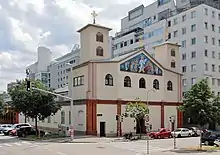 Serbian church in Vienna | |
| Total population | |
|---|---|
| 500,000 (2010), Serbian origins[1] 122.364 (2020), Serbian citizenships[2] | |
| Regions with significant populations | |
| Wien, Salzburg, Graz | |
| Languages | |
| Serbian and Austrian German | |
| Religion | |
| Serbian Orthodox Church |
| Part of a series of articles on |
| Serbs |
|---|
 |
History
_(BildID_15802162).jpg.webp)
Serbs have very long historical presence on the territory of modern Austria. By the end of the Middle Ages, migration of ethnic Serbs towards Austrian lands was caused by expansion of the Ottoman Empire. Exiled members of Serbian noble families were welcomed by Habsburg rulers, who granted them new possessions. In 1479, emperor Friedrich III granted castle Weitensfeld in Carinthia to exiled members of Branković dynasty of Serbia.[3]
During the period of Ottoman–Habsburg wars (from 16th to 18th century), Austrian policy towards Serbs was marked by special interests, related to complex political situation in various regions of the expanding Habsburg Monarchy. Emperor Leopold I issued several charters (1690, 1691, 1695) to Eastern Orthodox Serbs, who sided with Habsburgs during the Vienna War (1683-1699), granting them religious freedom in the Monarchy. Serbian Orthodox patriarch Arsenije III visited Austrian capital (Vienna) on several occasions, and died there in 1706.[4]
Serbian Orthodox metropolitan Isaija Đaković, who visited Austrian capital on several occasions since 1690, also died in Vienna, in 1708.[5] During the 18th and 19th century, new communities of ethnic Serbs were developing in major Austrian cities, consisted mainly of merchants, officers and students, who were under the spiritual jurisdiction of the Serbian Orthodox Metropolitanate of Karlovci.[6]
The Österreichisch Serbische Gesellschaft (Austrian Serbian Society) was founded in 1936 as "Österreichisch-Jugoslawischen Gesellschaft".
In 2011, the Serbian Orthodox Eparchy of Austria and Switzerland was created, centered in Vienna.[7]
Demographics
According to the 2014 census, there were 132,553 (2.2%) Austrian citizens who declared Serbian as their native language.[8] The real number of ethnic Serbs in Austria is estimated to be much higher – e.g. the membership of "Serbische Gemeinschaft in Österreich" (Savez Srba u Austriji), an ethnic Serb association in Austria, exceeds 250,000 people.[9] The common estimation is a total of 300,000.[10][11][12]
Notable people
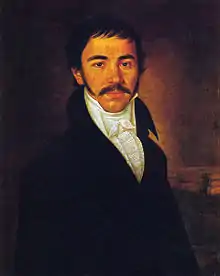 | 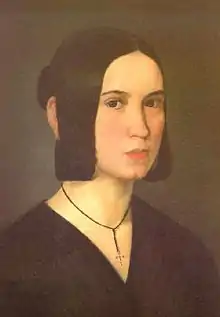 | 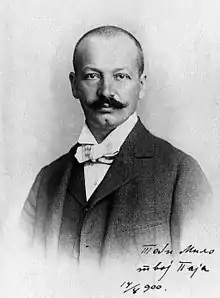 | 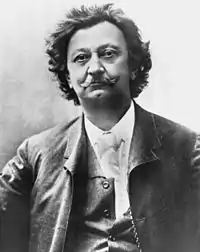 |  | 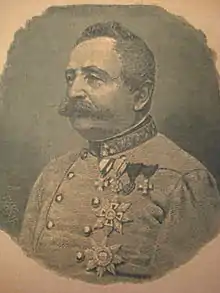 | 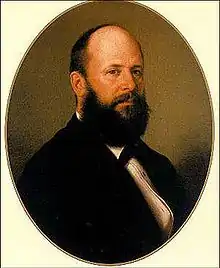 | 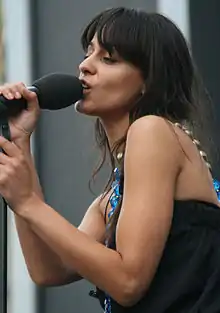 | 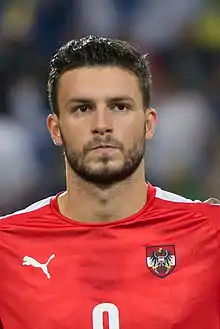 |  |  |
Military and political figures
- Baron Gabriel von Rodich, general and Governor of Dalmatia
- Paul von Radivojevich, general of the Napoleonic Wars
- Paul Davidovich, general of the Napoleonic Wars
- Raoul Stojsavljevic, World War I flying ace
- Konstantin Vojnović, politician and professor
- Svetozar Borojevic,
Writers and artists
- Vuk Stefanović Karadžić, reformer of the Serbian language
- Jovan Jovanović Zmaj, poet
- Pavle Julinac writer
- Mina Karadžić, painter and writer
- Paja Jovanović, Realist painter
- Mileva Roller, painter of the Vienna Secession movement
- Laza Kostić, poet
- Madita, singer
Athletes
- Marko Arnautović, football player
- Marco Djuricin, football player
- Aleksandar Dragović, football player
- Marko Stanković football player
- Zlatko Junuzović, football player
- Goran Djuricin, football coach and former player
- Damir Canadi, football coach
- Neno Ašćerić, basketball coach and former player
- Luka Ašćerić, basketball player
- Jasminka Cive, kickboxer and mixed martial artist
References
- "Srbi u Austriji traže status nacionalne manjine". Blic. 2010-10-02.
- "Bevölkerungsstruktur". www.statistik.at (in German). Statitstik Austria. February 12, 2020. Retrieved April 19, 2020.
Bevölkerungszahl Österreichs stieg auf mehr als 8,9 Mio. zu Jahresbeginn 2020
- Jireček 1918, p. 245.
- Ćirković 2004, p. 143-150.
- Ćirković 2004, p. 143, 150.
- Stiegnitz & Kosinski 1990, p. 22-23.
- Diözese von Österreich und der Schweiz
- AUSTRIA, STATISTIK. "Bevölkerung nach Staatsangehörigkeit und Geburtsland". Statistik.at. Retrieved 9 January 2018.
- "Archived copy". Archived from the original on 2011-07-21. Retrieved 2011-07-21.CS1 maint: archived copy as title (link)
- Palić, Svetlana (17 July 2011). "Četiri miliona Srba našlo uhlebljenje u inostranstvu". Blic.
Austriji (300.000)
- "Serben-Demo eskaliert in Wien". 20 Minuten Online. 2008.
- "Srbi u Austriji traže status nacionalne manjine". Blic. 2010-10-02.
"Srba u Austriji ima oko 300.000, po brojnosti su drugi odmah iza Austrijanaca i više ih je od Slovenaca, Mađara i Gradištanskih Hrvata zajedno, koji po državnom ugovoru iz 1955. godine imaju status nacionalne manjine u Austriji", navodi se u saopštenju.
Literature
- Ćirković, Sima (2004). The Serbs. Malden: Blackwell Publishing.CS1 maint: ref=harv (link)
- Jireček, Constantin (1918). Geschichte der Serben. 2. Gotha: Perthes.CS1 maint: ref=harv (link)
- Stiegnitz, Peter; Kosinski, Danuta (1990). Religions in Austria. Vienna: Federal Press Service.CS1 maint: ref=harv (link)
- Todorović, Jelena (2006). An Orthodox Festival Book in the Habsburg Empire: Zaharija Orfelin's Festive Greeting to Mojsej Putnik (1757). Aldershot: Ashgate Publishing.CS1 maint: ref=harv (link)
